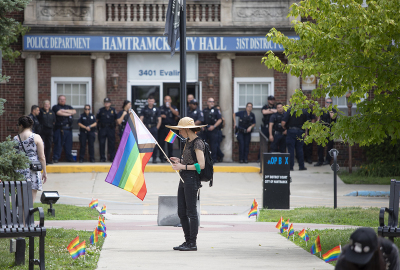Understanding gender ideology

We live in a time when the culture-forming institutions of the Western world (e.g., education, mass media, big business, some sectors of government) actively promote the idea that a man can become a woman (or vice versa), that gender is a spectrum, that one’s internal feelings at any given time determine one’s gender, and that to oppose any of these ideas is an act of malicious discrimination.
Teenagers and young adults, especially, are beholden to these views, which means that church leaders need to understand them and respond to them in light of Scripture, reason, and science. Gender ideology[1] is a vast and complex topic, but I’ll endeavor in this article to set forth and critique its key tenets so that those ministering to Christian young people will be equipped to understand and respond to it.
One caveat before I begin is that the ideology I’m addressing is primarily promoted by activists and academics, many of whom have influential platforms. My critique of these ideas is not meant to deny the very real experience of those who suffer from gender dysphoria or feel conflicted about their gender identity. There is a significant difference, however, between experiencing such feelings and making them the basis for dubious claims about human nature, and it is the latter position that I aim to challenge here. The Church and individual Christians should come alongside those who suffer from gender dysphoria and offer support, encouragement, and pastoral counsel.
Definitions
Before we go further, it will be helpful to briefly define some of the key terms related to current discussions about gender.[2]
(Biological) Sex: Biological make-up or composition related to sexual reproduction reflected in the hormonal, anatomical, and reproductive differences between men and women resulting from their chromosomal differences.
Gender: This term has different meanings, depending on the context in which it is used. As defined by Webster, it can be a synonym for biological sex (e.g., “the male gender”), or can refer to “the behavioral, cultural, or psychological traits typically associated with one sex.”[3] Activists tend to use “gender” in the sense of “gender identity” (see below), which can create confusion when trying to analyze their claims. Most also insist that “gender” is a “spectrum.”[4] I’ll argue below that this is misguided scientifically, philosophically, and biblically.
Gender Identity: A person’s self-perception of whether they are male or female, masculine or feminine.
Gender Dysphoria: Experiencing distress, inner anguish, or discomfort from sensing a conflict between one’s gender identity and one’s biological sex.[5]
Transgender: An umbrella term for the state or condition of identifying or expressing a gender identity that does not match a person’s genetic sex. It may mean dressing in the culturally determined dress of the gender that someone identifies with; it may involve someone having hormonal treatment to seek to bring their chemical balance into alignment with that gender; and it could include undergoing surgical treatment to alter their bodies. It may also mean not identifying as one gender all the time (which is often termed “gender fluid”) or not identifying as male or female at all (usually called “non-binary” or “agender”).
Key tenets of gender ideology
It’s remarkably difficult to find a list of beliefs or principles related to gender on websites devoted to LGBTQ issues and advocacy. Typically, terms are presented and defined (as we’ve done above), but there is no attempt to lay out a coherent set of ideas on gender and offer evidence or arguments to support them. This is likely due to the difficulties that would entail in terms of making a coherent case and offering evidence to substantiate it. Many activists on these issues have sought to avoid debate, unfortunately, by labeling those who challenge them as hateful or otherwise unworthy of engagement. This has proven to be a powerful rhetorical move that enables them to make assertions without having to defend their position. Despite the lack of systematically presented beliefs, the following is a distillation of the most common assertions of gender ideology.
There is little, or possibly no, connection between a person’s biological sex and their gender identity. Activists (and those who follow their lead) now frequently replace “biological sex” with “sex assigned at birth” since “The assignment of a biological sex may or may not align with what’s going on with a person’s body, how they feel, or how they identify.”[6]
One’s feelings alone determine one’s gender identity. These feelings may change over time so one’s gender identity also changes over time.[7]
A natal male who identifies as a female is, in fact, a woman. A natal female who identifies as a male is, in fact, a man. A transgender man or woman is as much a man or woman as a biological man or woman.[8]
Gender is a spectrum, and not limited to male or female. Other purported genders include non-binary, genderqueer, genderfluid, agender, two-spirit, and demigender, to name a few.
To fail to affirm a person’s gender identity is to attack their sense of self and personhood. Thus, it is appropriate to pass laws that compel individuals and institutions to use a person’s preferred pronouns and to allow them to use facilities like locker rooms, showers, and bathrooms that match their gender identity.[9]
Scientific and philosophical responses
Although some activists claim that biological sex is a spectrum, this has no basis in biology.[10] Human beings are sexually dimorphic because they exhibit exactly two reproductive roles — male and female. As Anderson observes, “Sex ... is identified by the organization of the organism for sexually reproductive acts ... The fundamental conceptual distinction between a male and a female is the organism’s organization for sexual reproduction.”[11]
After conducting a thorough review of the relevant scientific literature, professor of psychiatry and behavioral sciences Paul McHugh and professor of statistics and biostatistics Lawrence Mayer concluded that “The hypothesis that gender identity is an innate, fixed property of human beings that is independent of biological sex — that a person might be ‘a man trapped in a woman’s body’ or ‘a woman trapped in a man’s body’ — is not supported by scientific evidence.”[12]
To reiterate a point made earlier, although science gives no support to the idea that one can be or become a different sex than what one’s biology indicates, it is also true that those who suffer from gender dysphoria can have strong, subjective feelings that they have a gender identity that doesn’t match their biological sex. I sympathize with them and will say more below about how I believe that mismatch is best addressed.
Returning to gender ideology, to drive a wedge between biology and gender is to untether a person from the physical reality of their own body. As Nancy Pearcey observes, in our postmodern culture, “The body has become a morally neutral piece of matter that can be manipulated for whatever purposes the self may impose on it — like pressing a mold into clay or stamping Lincoln’s profile on a copper penny.” In stark contrast to this is the Christian view that “assigns the human body a much richer dignity and value. Humans do not need freedom from the body to discover their true, authentic self. Rather we can celebrate our embodied existence as a good gift from God. Instead of escaping from the body, the goal is to live in harmony with it.”[13]
A number of gender ideology claims are also contradictory. As Anderson points out:
They claim that the real self is something other than the physical body, in a new form of Gnostic dualism, yet at the same time, they embrace a materialist philosophy in which only the material world exists. They say that gender is purely a social construct while asserting that a person can be “trapped” in the wrong gender.
They say there are no meaningful differences between men and women, yet they rely on rigid sex stereotypes to argue that “gender identity” is real, while human embodiment is not. They claim that truth is whatever a person says it is, yet they believe there’s a real self to be discovered inside that person.
They promote a radical expressive individualism in which people are free to do whatever they want and define the truth however they wish, yet they try ruthlessly to enforce acceptance of transgender ideology.[14]
Scriptural response
In addition to scientific and conceptual difficulties, there are also strong scriptural reasons for rejecting gender ideology. As I’ve written elsewhere, the first chapter of Genesis reveals God’s design for human beings as men and women who collectively reflect his image. I won’t repeat that material here, but suffice it to say that God created human beings as a gender binary, and there is no indication in Genesis or the rest of the canon that there is a third option, or that men or women can transform into the opposite sex or gender. Instead, this design reflects God’s intention for us, which he describes as “very good” (Gen. 1:31). As Andrew Walker rightly notes,
"Being creatures means that we cannot re-create ourselves in any fashion or form that we desire by a simple act of the will or the complex work of a surgeon. When we as creatures reject the Creator’s blueprint, we are both rebelling against the natural order of how things objectively are, and (though it may not seem like it) we are rejecting the life that is going to be the highest good for us."[15]
Christians should compassionately empathize with those who experience gender dysphoria or feel conflicted about their gender identity. The severity of these feelings varies from person to person but can be quite distressing and debilitating. A supportive family, friends, church, and professional Christian therapy can help those who struggle in this area. One key challenge, however, is to not let feelings (however strong) redefine reality or become the foundation of our identity. As Branch writes, since it is contrary to Scripture to hold that one is the opposite sex, for people “experiencing gender dysphoria, it is more accurate to say, ‘I am a [male or female] made in the image of God with both a body and soul, but I am experiencing confused feelings about gender right now.’”[16] Because of Adam and Eve’s fall, human beings (and all of creation) bear the corrupting consequences, which manifest themselves physically, mentally, emotionally, and spiritually.
Ultimately, for any human being to truly flourish, they must find their identity in Christ. Branch helpfully summarizes,
In Christ, my old self is crucified (Rom 6:6). In Christ, I am now “clothed ... with Christ” (Gal 3:27). In Christ, my body is a temple of the Holy Spirit (1 Cor 6:19). In Christ, I have died to my old life and my life is now hidden in God (Col 3:3). In Christ, I am a new creation (2 Cor 5:17). In Christ, I am forgiven (Eph 1:7). As Christians, our identity is always in Christ. Anything else we embrace as our identity is a false idol competing for worship. Building one’s life around a transgender identity ... is the path away from peace and victory.[17]
*This article originally appeared at Summit Ministries.
Notes
By gender ideology, I mean the radical and revisionist ideas about gender described throughout this article.
The following (commonly accepted) definitions are taken primarily from Andrew T. Walker, God and the Transgender Debate: What Does the Bible Actually Say about Gender Identity?, 2nd ed. (The Good Book Company, 2022), 24-28.
https://www.merriam-webster.com/dictionary/gender.
“One’s gender identity could be woman, man, transgender, nonbinary, or an infinite number of other possibilities” (“A Scientist Explains Why Gender [and Sex] Aren’t Binary,” https://cadehildreth.com/gender-spectrum/). Those who adopt gender ideology tend to incorporate contradictory elements of biological determinism and sociological relativism into their understanding of “gender.” They presuppose, for example, that “gender” is socially constructed but also biologically fixed.
The current (fifth edition) of the Diagnostic and Statistical Manual of Mental Disorders lists gender dysphoria as a mental disorder, but only in cases “associated with clinically significant distress or impairment in social, occupational, or other important areas of functioning” (cited in “What is Gender Dysphoria? https://www.psychiatry.org:443/patients-families/gender-dysphoria/what-is-gender-dysphoria).
“Sex and Gender Identity,” https://www.plannedparenthood.org/learn/gender-identity/sex-gender-identity. It’s nonsensical, of course, to claim that biological sex is arbitrarily “assigned” at birth. Except in rare cases where disorders of sexual development (DSDs) are present, a newborn’s sex is obvious. Even in cases of DSDs, the newborn is still either male or female. There may be developmental abnormalities, but there is no third possibility when it comes to an individual’s sex. “As the pediatric endocrinologist Quentin L. Van Meter writes, ‘The exceedingly rare DSDs are all medically identifiable deviations from the sexual binary norm. The 2006 consensus statement of the Intersex Society of North America and the 2015 revision of the statement does not endorse DSD as a third sex.’” (Ryan T. Anderson, When Harry Became Sally: Responding to the Transgender Moment [New York: Encounter Books, 2018], 88).
“Your gender identity is how you feel inside and how you express those feelings” (“Sex and Gender Identity”).
The Human Rights Campaign advises, “Refrain from contrasting trans men and women with ‘real’ or ‘biological’ men and women. Contrasting transgender people with ‘real’ or ‘biological’ men and women is a false comparison. They are real men and women, and doing so contributes to the inaccurate perception that transgender people are being deceptive when, in fact, they are being authentic and courageous,” (“HRC’s Brief Guide to Getting Transgender Coverage Right,” https://www.hrc.org/resources/reporting-about-transgender-people-read-this).
In New York City, for example, an employer can be fined up to $250,000 for failing to comply in these areas (“Gender Identity/Gender Expression – CCHR,” https://www.nyc.gov/site/cchr/law/legal-guidances-gender-identity-expression.page). Many view this as speech compelled by the government to affirm currently popular gender ideology. Eugene Volokh argues that this is equivalent to compelling someone to address another person as “Milord,” “Your Holiness,” or “thee” (“Opinion | You Can Be Fined for Not Calling People ‘Ze’ or ‘Hir,’ If That’s the Pronoun They Demand That You Use,” Washington Post, October 23, 2021, https://www.washingtonpost.com/news/volokh-conspiracy/wp/2016/05/17/you-can-be-fined-for-not-calling-people-ze-or-hir-if-thats-the-pronoun-they-demand-that-you-use/).
By “gender” here, I mean biological sex. Activists seek to completely sever the concept of gender from biological sex, but this tears the concept away from its physical and linguistic foundations, robbing it of meaning in the process. Masculinity and femininity could be described as a spectrum (e.g., a woman exhibiting more or fewer typically feminine traits), but biological sex cannot. Severing the term “gender” from biological sex leads to incoherent claims, such as a person being neither male nor female, or both at the same time, or being male one week and female the next. These are descriptions that in no way map onto physical reality.
Anderson, Harry Became Sally, 79.
“Executive Summary – Sexuality and Gender,” The New Atlantis, https://www.thenewatlantis.com/publications/executive-summary-sexuality-and-gender. McHugh taught at Johns Hopkins University School of Medicine, and for twenty-five years was the psychiatrist-in-chief at the Johns Hopkins Hospital. The New Atlantis notes that McHugh is “arguably the most important American psychiatrist of the last half-century.”
Nancy R. Pearcey, Love Thy Body: Answering Hard Questions about Life and Sexuality (Grand Rapids: Baker, 2018), 203, 210. For a helpful exploration of how the West has become characterized by “expressive individualism” that seeks to conform reality to human desire, see Carl R. Trueman, The Rise and Triumph of the Modern Self: Cultural Amnesia, Expressive Individualism, and the Road to Sexual Revolution (Crossway, 2020).
Ryan Anderson, “Transgender Ideology Is Riddled With Contradictions. Here Are the Big Ones,” https://www.heritage.org/gender/commentary/transgender-ideology-riddled-contradictions-here-are-the-big-one.
Walker, God and the Transgender Debate, 48. Also see Deuteronomy 22:5, which prohibits men from presenting as women, and vice versa. J. Alan Branch comments, “While many people think the biblical prohibition of cross-dressing is obscurantist, the clothing of the cross-dresser acts as a proxy for embodiment and a corresponding rejection of God’s will” (J. Alan Branch, Affirming God’s Image: Addressing the Transgender Question with Science and Scripture (Bellingham, WA: Lexham Press, 2019), 44.
Ibid., 50.
Ibid., 142.
Christopher L. Reese (MDiv, ThM) is a writer, editor, and journalist. He is the founder and editor of The Worldview Bulletin and a general editor of the Dictionary of Christianity and Science (Zondervan, 2017) and Three Views on Christianity and Science (Zondervan, 2021). His work has appeared in Christianity Today, Bible Gateway, Beliefnet, Summit Ministries, and other sites.




























